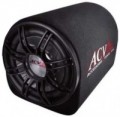Body shape
—
Case Box. Literally "box". The simplest type of case, in fact, is a box of medium dimensions, designed for installation in the boot.
— Compact. This option means rather than the shape, but the size of the case — as the name implies, it includes devices that have small dimensions. Such subwoofers are as simple as possible to install, some models can be installed directly
under the seat. At the same time, their sound quality and power are usually lower than those of full-size ones.
— Tube. The case is in the form of a pipe, on one of the ends of which a speaker is displayed. This form does not significantly affect the sound characteristics, it plays mainly an aesthetic role —
subwoofers-pipes look quite stylish.
Size
The size (diameter) of the main subwoofer speaker. In all types of subwoofers, this parameter primarily affects the power and depth of sound: the larger the speaker, the louder it is and the deeper the bass it can provide (ceteris paribus). However with an increase in the size and dimensions, they increase accordingly, which determines the installation possibilities. The latter is especially true in Free Air subwoofers (see "Execution"): some cars are initially equipped with "seats" for a certain size, and it is difficult to install models with other dimensions there.
Now on the market there are subwoofers with such popular sizes:
5" (13 cm),
6" (15.25 cm),
6.3" (16 cm),
6.5" (16.5 cm),
6.75" (17 cm),
8" (20 cm ),
8.25"(21cm) , 9" (23cm
), 10" (25cm
),
11" (27cm),
12"(30cm) ,
13" (33cm),
15"(38cm) ,
16 " (40 cm),
18" (46 cm).
Rated power
The average (root mean square — RMS) power of the input signal, at which the subwoofer is able to work continuously without negative consequences (damage, failure) for at least an hour. The rated power of the subwoofer must be greater than the power of the amplifier connected to it — in order to avoid overloads.
Max. power
The maximum signal power that the subwoofer is able to withstand for a short time (up to several seconds) without any negative consequences. When selecting an amplifier-subwoofer pair, it is recommended to take a subwoofer with a maximum power of at least twice the maximum power of the amplifier. In general, the higher the maximum power, the more resistant the subwoofer is to overloads.
Frequency range
The range of audio frequencies reproduced by the subwoofer. It is believed that the human ear is capable of perceiving a frequency range of the order of 16 – 20,000 Hz, but in this case note that the subwoofer is designed to reproduce the lower frequency band (up to 200 Hz). Accordingly, in the case of the lower limit of the range, everything is simple: “the lower, the better”; the upper one should not be lower than the lower limit of the main car audio — otherwise there will be "gaps" in the frequencies, which will affect the sound quality.
Sensitivity
Sensitivity determines the loudness of the subwoofer when a signal of a certain power is connected to it: with equal signal power and impedance (see below), the subwoofer with the higher sensitivity will sound louder.
Dual voice coil
A dual voice coil is actually two separate voice coils on the same speaker. This allows you to connect two amplifiers to the subwoofer at once, thus providing high sound power.
Phase control
The ability
to change the phase of the sound coming from the subwoofer, in other words, the ability to adjust the sound from the subwoofer to lead or lag relative to the main speakers. This need may be due to the fact that the sound from the main speakers and from the subwoofer can reach the listener with different delays — due to the location of the speakers and the features of the electronics — which negatively affects the sound quality. Adjusting the phases allows you to harmonize this sound. This feature is usually found in active subwoofers.
Subsonic filter
The presence in the subwoofer
of an infra-low frequency filter (Finch), also referred to as Subsonic. This filter "cuts" subsonic frequencies, preventing the subwoofer from reproducing them. Often this filter has a frequency control. This feature serves several purposes. Firstly, the human ear is no longer able to recognize such vibrations, and there is no point in reproducing them — this only leads to useless expenditure of energy. Secondly, intense infrasound can adversely affect well-being (both physical and mental). Thirdly, working with infra-low frequencies at high power can damage the subwoofer itself: figuratively speaking, the coil “blows” off the speaker.

